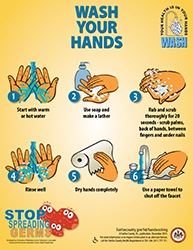Handwashing Posters

English | Arabic | Chinese | Farsi | Korean | Spanish | Urdu | Vietnamese
Employee Health Policy
Do your employees know what a foodborne illness is? Do your employees realize that they have a responsibility to the restaurant and to the customers to know how to prevent the spread of a foodborne illness? What do you do as a manager if an employee is diagnosed with, or has symptoms of, a foodborne illness? An employee health policy will provide the answers.
Use the employee health policy training packet to put an employee health policy in place in your food establishment. If your food establishment serves a highly susceptible population (HSP) (a nursing home or day care, for example), please print the Decision Guide for an HSP (EHF31).
Employee Health Policy Training Packet
This training packet includes:
- For Managers - Let's Start an Employee Health Policy! (EHF45)
Information on how to present the training that will give your establishment a usable employee health policy.
- Form #1: What Is Foodborne Illness? (EHF46)
Training sheet to explain the importance of preventing foodborne illness to your employees.
- Form #2: Employee Illness Reporting Agreement (EHF47)
Training tool to help employees understand their role in preventing foodborne illness.
- Form #3: Employee Health Decision Guide for Managers (EHF48)
Question and answer sheet to help managers determine if an ill employee should be allowed to work in the restaurant.
- Employee Illness Decision Guide Tool to determine if an employee with an undiagnosed illness can spread the illness through food and should be restricted or excluded from work.
- If your establishment serves an HSP, e.g., elderly, children or people who have a weakened immune system, use the HSP decision guide (EHF31).
- If your establishment does not serve an HSP, use the non-HSP decision guide (EHF19).
- Employee Absence/Illness Record (EHF67)
Log to monitor employee absences due to illness.
English | Arabic | Chinese | Farsi | Korean | Spanish | Thai | Urdu | Vietnamese
Cooling — the Right Way
Sometimes it is necessary to prepare foods in advance and store them for later use. Leaving the hot food on the counter for a couple of hours or placing it immediately in a refrigerator may only lead to bacterial growth which can lead to your customers getting sick. Use the resources below to get cooling done the right way.
Consumer Advisory
If an animal food such as beef, eggs, fish, lamb, milk, pork, poultry or shellfish is served or sold raw, the restaurant operator must make the consumer aware of the risk of foodborne illness by providing written information to the consumer.
Parasite Destruction Letter Requirement
If an establishment serves raw fish (e.g., sushi, sashimi or ceviche) to its customers, the operator must provide proof that the fish has been frozen for parasite destruction. Often this proof is in the form of a parasite destruction letter from the fish distributor saying that the fish has been frozen in a manner to kill parasites. There is specific information to be included in the letter.
English | Korean | Spanish
Prevent Cross-Contamination Poster
Foods must be stored in a refrigerator in a way to prevent cross-contamination. Place this poster on the outside of the refrigerator.
English | Arabic | Chinese | Farsi | Hindi | Korean | Spanish | Thai | Urdu | Vietnamese
Time as the Public Health Control
Generally, foods must be kept hot (greater than 135°F) or cold (less than 41°F). These temperatures are the controls to reduce the occurrence of foodborne illness. In some instances, time may be used as the public health control. Using time as the public health control means that foods which are normally under temperature control (hot or cold) are kept under no temperature control. To use this method properly, a number of requirements must be met.
English | Chinese | Korean | Spanish | Vietnamese
Understanding Your Grease Trap/Interceptor
English | Chinese | Korean | Spanish | Vietnamese
Vomit and Diarrhea Clean-up
English | Arabic | Chinese | Korean | Spanish | Vietnamese
Big Six Foodborne Illnesses
English